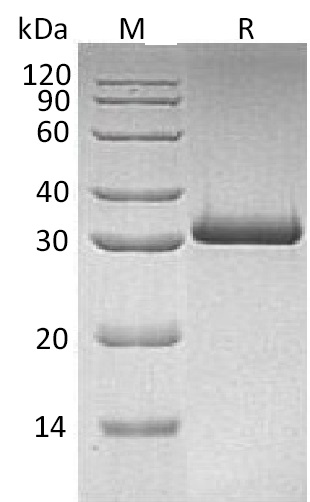- Remove All
 Your shopping cart is currently empty
Your shopping cart is currently empty
MBL2 Protein, Human, Recombinant (His)
Mannose-Binding Protein C (MBP-C) belongs to the Collectin family of innate immune defense proteins. MBL binds to an array of carbohydrate patterns on pathogen surfaces. Collectin family members share common structural features: a cysteine rich amino-terminal domain, a collagen-like region, an α-helical coiled-coil neck domain and a carboxy terminal C-type Lectin or carbohydrate recognition domain (CRD). MBL homotrimerizes to form a structural unit joined by N-terminal disulfide bridges. These homotrimers further associates into oligomeric structures of up to 6 units. Whereas two forms of MBL proteins exist in rodents and other animals. Human MBL-2 is 25 kDa. Human MBL-2 is a secreted glycoprotein that is synthesized as a 248 amino acid (aa) precursor that contains a 20 aa signal sequence, a 21 aa cysteine-rich region, a 58 aa collagen-like segment and a 111 aa C-type lectin domain that binds to neutral bacterial carbohydrates.

MBL2 Protein, Human, Recombinant (His)
| Pack Size | Price | Availability | Quantity |
|---|---|---|---|
| 10 μg | $97 | 7-10 days | |
| 50 μg | $272 | 7-10 days | |
| 500 μg | $1,900 | 7-10 days | |
| 1 mg | $2,730 | 7-10 days |
Product Information
| Biological Activity | Activity has not been tested. It is theoretically active, but we cannot guarantee it. If you require protein activity, we recommend choosing the eukaryotic expression version first. |
| Description | Mannose-Binding Protein C (MBP-C) belongs to the Collectin family of innate immune defense proteins. MBL binds to an array of carbohydrate patterns on pathogen surfaces. Collectin family members share common structural features: a cysteine rich amino-terminal domain, a collagen-like region, an α-helical coiled-coil neck domain and a carboxy terminal C-type Lectin or carbohydrate recognition domain (CRD). MBL homotrimerizes to form a structural unit joined by N-terminal disulfide bridges. These homotrimers further associates into oligomeric structures of up to 6 units. Whereas two forms of MBL proteins exist in rodents and other animals. Human MBL-2 is 25 kDa. Human MBL-2 is a secreted glycoprotein that is synthesized as a 248 amino acid (aa) precursor that contains a 20 aa signal sequence, a 21 aa cysteine-rich region, a 58 aa collagen-like segment and a 111 aa C-type lectin domain that binds to neutral bacterial carbohydrates. |
| Species | Human |
| Expression System | HEK293 Cells |
| Tag | C-6xHis |
| Accession Number | P11226 |
| Synonyms | MBP-C,MBP1,MBL2,MBL,Mannose-Binding Protein C,Mannose-Binding Lectin,Mannan-Binding Protein,Collectin-1,COLEC1 |
| Amino Acid | Glu21-Ile248 |
| Construction | Glu21-Ile248 |
| Protein Purity | Greater than 95% as determined by reducing SDS-PAGE. (QC verified)  |
| Molecular Weight | 31 KDa (reducing condition) |
| Endotoxin | < 0.1 ng/µg (1 EU/µg) as determined by LAL test. |
| Formulation | Lyophilized from a solution filtered through a 0.22 μm filter, containing 20 mM PB, 150 mM NaCl, 5% Threhalose, pH 7.2. |
| Reconstitution | Reconstitute the lyophilized protein in distilled water. The product concentration should not be less than 100 μg/ml. Before opening, centrifuge the tube to collect powder at the bottom. After adding the reconstitution buffer, avoid vortexing or pipetting for mixing. |
| Stability & Storage | Lyophilized powders can be stably stored for over 12 months, while liquid products can be stored for 6-12 months at -80°C. For reconstituted protein solutions, the solution can be stored at -20°C to -80°C for at least 3 months. Please avoid multiple freeze-thaw cycles and store products in aliquots. |
| Shipping | In general, Lyophilized powders are shipping with blue ice. Solutions are shipping with dry ice. |
| Research Background | Mannose-Binding Protein C (MBP-C) belongs to the Collectin family of innate immune defense proteins. MBL binds to an array of carbohydrate patterns on pathogen surfaces. Collectin family members share common structural features: a cysteine rich amino-terminal domain, a collagen-like region, an α-helical coiled-coil neck domain and a carboxy terminal C-type Lectin or carbohydrate recognition domain (CRD). MBL homotrimerizes to form a structural unit joined by N-terminal disulfide bridges. These homotrimers further associates into oligomeric structures of up to 6 units. Whereas two forms of MBL proteins exist in rodents and other animals. Human MBL-2 is 25 kDa. Human MBL-2 is a secreted glycoprotein that is synthesized as a 248 amino acid (aa) precursor that contains a 20 aa signal sequence, a 21 aa cysteine-rich region, a 58 aa collagen-like segment and a 111 aa C-type lectin domain that binds to neutral bacterial carbohydrates. |
Dose Conversion
Sci Citations
Calculator
Tech Support

Copyright © 2015-2025 TargetMol Chemicals Inc. All Rights Reserved.


